A Dynamic Iwan Model to Describe the Impact Failure of Bolted Joints
Abstract
:1. Introduction
2. Numerical Model of Bolted Joints
3. Parametric Analysis
4. Dynamic Iwan Model
4.1. Analytical Development
4.2. Parameter Identification
4.2.1. Sliding
4.2.2. Collision
5. Results and Discussions
6. Conclusions
- The response of bolted joints under impact loading consists of three main stages, namely slip, collision and bolt shear failure, and the developed fine finite element model can accurately simulate the form of damage, including the shear fracture of the bolt and the prediction of the critical load.
- Numerical simulation results show that increases in velocity and friction coefficient lead to an increase in critical load, whereas preload leads to a decrease. In addition, critical load and critical displacement are linearly related to the normalized logarithmic velocity and the normalized preload and friction coefficient.
- A dynamic Iwan model (DICF model) is proposed to describe the dynamic response of bolted joints under impact loading, the constitutive relationship is derived and a parameter identification procedure is proposed. The parameters can be obtained from experimental or numerical simulation results to accurately predict the force–displacement relationship for different velocities, preloads and friction coefficients.
- Calculation of the refined finite element model is inefficient due to the contact interfaces and the complexity of the threads. In this study, a model is presented to describe the force–displacement relationship of bolted joints under impact loading more conveniently, which can be used in future studies to characterize the impact response of large structures containing bolted joints.
Author Contributions
Funding
Data Availability Statement
Acknowledgments
Conflicts of Interest
References
- Du, F.; Wu, S.; Xu, C.; Yang, Z.; Su, Z. Electromechanical Impedance Temperature Compensation and Bolt Loosening Monitoring Based on Modified Unet and Multitask Learning. IEEE Sens. J. 2023, 23, 556–4567. [Google Scholar] [CrossRef]
- Warren, M.; Antoniou, A.; Stewart, L. A review of experimentation and computational modeling of dynamic bolt fracture. J. Constr. Steel Res. 2022, 194, 107293. [Google Scholar] [CrossRef]
- Zheng, Q.; Guo, Y.; Wei, Y.; Wang, Y.; Wang, X. Loosening of steel threaded connection subjected to axial compressive impact loading. Int. J. Impact Eng. 2020, 144, 103662. [Google Scholar] [CrossRef]
- Horsfall, I.; Hansen, B.; Carr, D. Security of Bolted Joints during Explosive Loading. Int. J. Veh. Struct. Syst. 2011, 3, 107. [Google Scholar] [CrossRef]
- Gao, S.; Li, J.; Guo, L.; Bai, Q.; Li, F. Mechanical properties and low-temperature impact toughness of high-strength bolts after elevated temperatures. J. Build. Eng. 2022, 57, 104851. [Google Scholar] [CrossRef]
- Tyas, A.; Warren, J.; Stoddart, E.; Davison, J.; Tait, S.; Huang, Y. A methodology for combined rotation-extension testing of simple steel beam to column joints at high rates of loading. Exp. Mech. 2012, 52, 1097–1109. [Google Scholar] [CrossRef]
- Ribeiro, J.; Santiago, A.; Rigueiro, C.; Barata, P.; Veljkovic, M. Numerical assessment of T-stub component subjected to impact loading. Eng. Struct. 2016, 106, 450–460. [Google Scholar] [CrossRef]
- Sanborn, M.J. Experimental Methods for Understanding the Behavior and Residual Capacity of Bolts and Steel Bolted Connections under Impulsive Loads. Ph.D. Dissertation, Georgia Institute of Technology, Atlanta, GA, USA, 2018. [Google Scholar]
- Sanborn, M.J.; Stewart, L.K. Method for evaluating impulsive shear and residual capacity behavior of bolted connections. Eng. Struct. 2020, 220, 110372. [Google Scholar] [CrossRef]
- Sanborn, M.J.; Stewart, L.K. Behavior of slip-critical bolted connections subjected to impulsive loads. Int. J. Impact Eng. 2020, 143, 103501. [Google Scholar] [CrossRef]
- Fransplass, H.; Langseth, M.; Hopperstad, O. Experimental and numerical study of threaded steel fasteners under combined tension and shear at elevated loading rates. Int. J. Impact Eng. 2015, 76, 118–125. [Google Scholar] [CrossRef]
- Ren, T.; Suo, T.; Meng, Y.; Gao, Y.; Wang, C.; Li, Y. On dynamic behavior and failure of high lock bolted joints: Testing, analysis and predicting. Eur. J. Mech.-A/Solids 2022, 96, 104681. [Google Scholar] [CrossRef]
- Wagner, T.; Heimbs, S.; Burger, U. A simplified and semi-analytical bolted joint model for crash and impact simulations of composite structures. Compos. Struct. 2020, 233, 111628. [Google Scholar] [CrossRef]
- Song, Y.; Wang, J.; Uy, B.; Li, D. Experimental behaviour and fracture prediction of austenitic stainless steel bolts under combined tension and shear. J. Constr. Steel Res. 2020, 166, 105916. [Google Scholar] [CrossRef]
- Cao, Z.; Brake, M.; Zhang, D. The failure mechanisms of fasteners under multi-axial loading. Eng. Fail. Anal. 2019, 105, 708–726. [Google Scholar] [CrossRef]
- Warren, M.; Sanborn, M.J.; Stewart, L.K. Characterization of A325 Structural Bolts Subjected to Impulsive Loads. In Proceedings of the ASME 2021 International Mechanical Engineering Congress and Exposition, Virtual, 1–5 November 2021; Volume 12, p. V012T12A002. [Google Scholar]
- Jalali, H.; Jamia, N.; Friswell, M.I.; Khodaparast, H.H.; Taghipour, J. A generalization of the Valanis model for friction modelling. Mech. Syst. Signal Process. 2022, 179, 109339. [Google Scholar] [CrossRef]
- Mathis, A.T.; Balaji, N.N.; Kuether, R.J.; Brink, A.R.; Brake, M.R.; Quinn, D.D. A review of damping models for structures with mechanical joints. Appl. Mech. Rev. 2020, 72, 040802. [Google Scholar] [CrossRef]
- Marques, F.; Woliński, Ł.; Wojtyra, M.; Flores, P.; Lankarani, H.M. An investigation of a novel LuGre-based friction force model. Mech. Mach. Theory 2021, 166, 104493. [Google Scholar] [CrossRef]
- Jia, T.; Liu, J.; Wang, Y.; Li, C.; Zhang, H. An improved LuGre friction model and its parameter identification of structural interface in thermal environment. Mech. Syst. Signal Process. 2024, 216, 111468. [Google Scholar] [CrossRef]
- Robat, A.B.; Arezoo, K.; Alipour, K.; Tarvirdizadeh, B. Dynamics modeling and path following controller of tractor-trailer-wheeled robots considering wheels slip. ISA Trans. 2024, 148, 45–63. [Google Scholar] [CrossRef]
- Yin, R.; Xue, B.; Brousseau, E.; Geng, Y.; Yan, Y. Characterizing the electric field- and rate-dependent hysteresis of piezoelectric ceramics shear motion with the Bouc-Wen model. Sens. Actuators A Phys. 2024, 367, 115044. [Google Scholar] [CrossRef]
- Maleki, M.; Ahmadian, H.; Rajabi, M. A modified Bouc-Wen model to simulate asymmetric hysteresis loop and stochastic model updating in frictional contacts. Int. J. Solids Struct. 2023, 269, 112212. [Google Scholar] [CrossRef]
- Mishra, M.K.; Samantaray, A.K.; Chakraborty, G. Fractional-order Bouc-wen hysteresis model for pneumatically actuated continuum manipulator. Mech. Mach. Theory 2022, 173, 104841. [Google Scholar] [CrossRef]
- Song, Y.; Hartwigsen, C.; McFarland, D.; Vakakis, A.F.; Bergman, L. Simulation of dynamics of beam structures with bolted joints using adjusted Iwan beam elements. J. Sound Vib. 2004, 273, 249–276. [Google Scholar] [CrossRef]
- Li, Y.; Hao, Z. A six-parameter Iwan model and its application. Mech. Syst. Signal Process. 2016, 68, 354–365. [Google Scholar] [CrossRef]
- Segalman, D.J.; Starr, M.J. Inversion of Masing models via continuous Iwan systems. Int. J. Non-Linear Mech. 2008, 4, 74–80. [Google Scholar] [CrossRef]
- Wang, D.; Xu, C.; Fan, X.; Wan, Q. Reduced-order modeling approach for frictional stick-slip behaviors of joint interface. Mech. Syst. Signal Process. 2018, 103, 131–138. [Google Scholar] [CrossRef]
- Brake, M. A reduced Iwan model that includes pinning for bolted joint mechanics. Nonlinear Dyn. 2017, 87, 1335–1349. [Google Scholar] [CrossRef]
- Shen, M.; Yang, X.; Gao, C.; Yang, J.; Shi, R.; Guo, P. Modeling and analyzing the influence of slip velocity on joint surface. Int. J. Non-Linear Mech. 2024, 165, 104798. [Google Scholar] [CrossRef]
- Ranjan, P.; Pandey, A.K. Modeling of pinning phenomenon in Iwan model for bolted joint. Tribol. Int. 2021, 161, 107071. [Google Scholar] [CrossRef]
- Li, D.; Botto, D.; Xu, C.; Liu, T.; Gola, M. A micro-slip friction modeling approach and its application in underplatform damper kinematics. Int. J. Mech. Sci. 2019, 161, 105029. [Google Scholar] [CrossRef]
- Wang, P.; Wulan, T.; Liu, M.; Qu, H.; You, Y. Shear behavior of lap connection using one-side bolts. Eng. Struct. 2019, 186, 64–85. [Google Scholar] [CrossRef]
- BS EN 1993-1-8; European Committer for Standardization. Eurocode3: Design of Steel Structures, Part1–8: Design of Joints. The Spanish Association for Standardization and Certification: Madrid, Spain, 2005.
- Sirigiri, V.K.R.; Gudiga, V.Y.; Gattu, U.S.; Suneesh, G.; Buddaraju, K.M. A review on Johnson Cook material model. Mater. Today Proc. 2022, 62, 3450–3456. [Google Scholar] [CrossRef]
- Wei, G.; Zhang, W.; Deng, Y. Identification and validation of constitutive parameters of 45 Steel based on J-C model. J. Vib. Shock 2019, 38, 173–178. [Google Scholar]
- Chen, G.; Chen, Z.; Xu, W. Investigation on the J-C ductile fracture parameters of 45 steel. Explos. Shock Waves 2007, 27, 131–135. [Google Scholar]
- Li, L.; Haung, B.; Xiao, X.; Zhu, Y.; Xu, T. Behavior of dynamic material Q355B steel based on the Johnson-Cook model. J. Vib. Shock 2020, 39, 231–237. [Google Scholar]
- Cong, L.; Ren, M.; Shi, J.; Yang, F.; Guo, G. Experimental investigation on performance deterioration of asphalt mixture under freeze–thaw cycles. Int. J. Transp. Sci. Technol. 2020, 9, 218–228. [Google Scholar] [CrossRef]

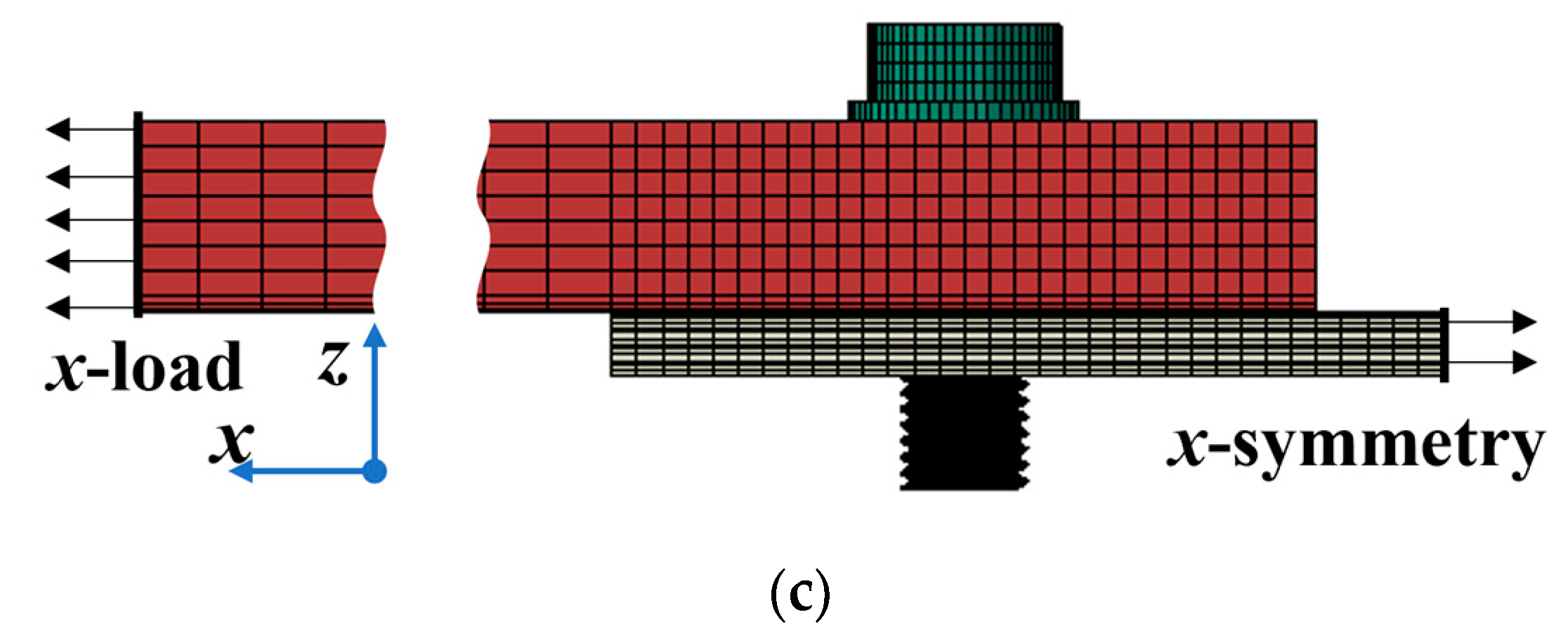
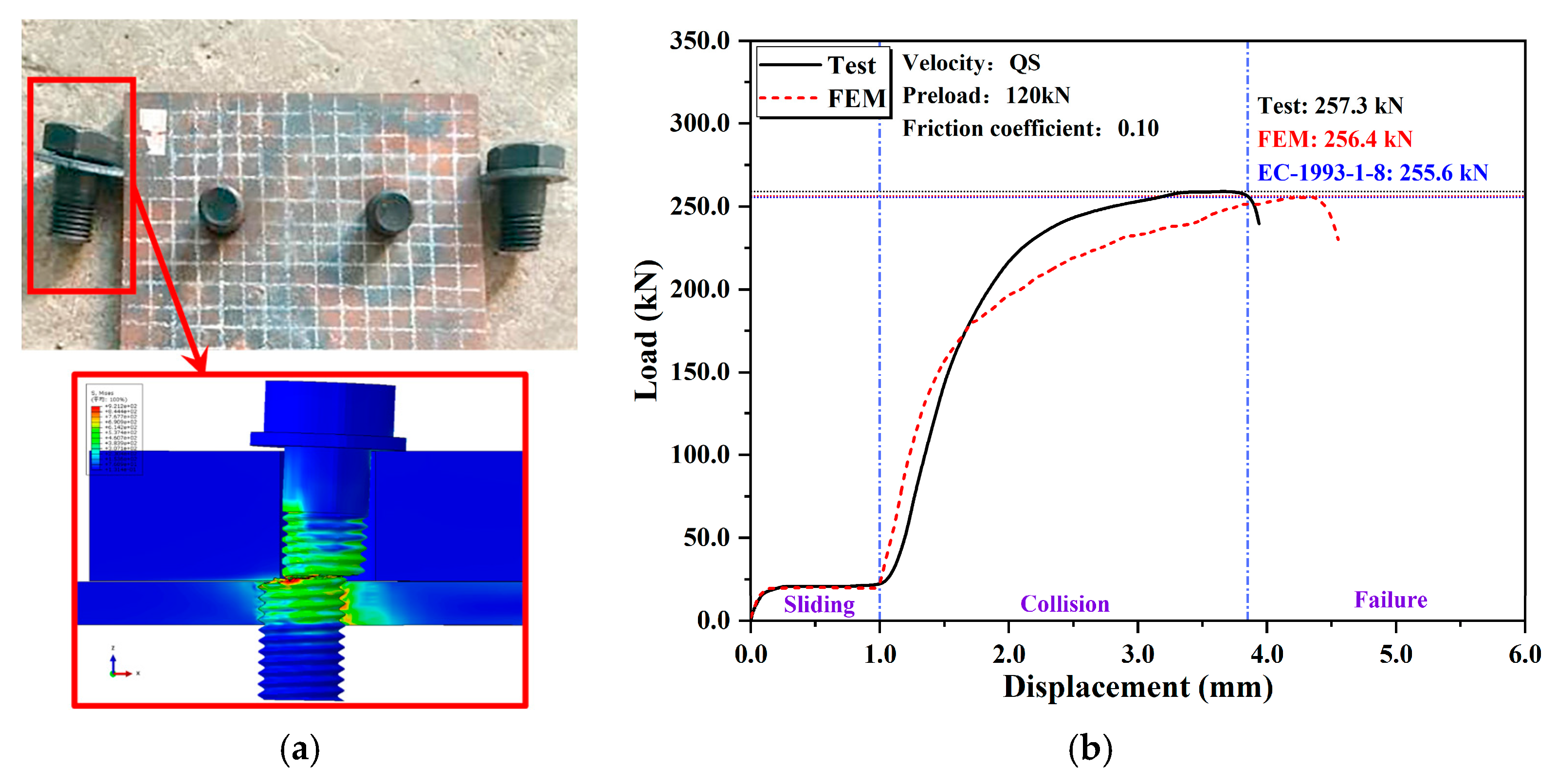
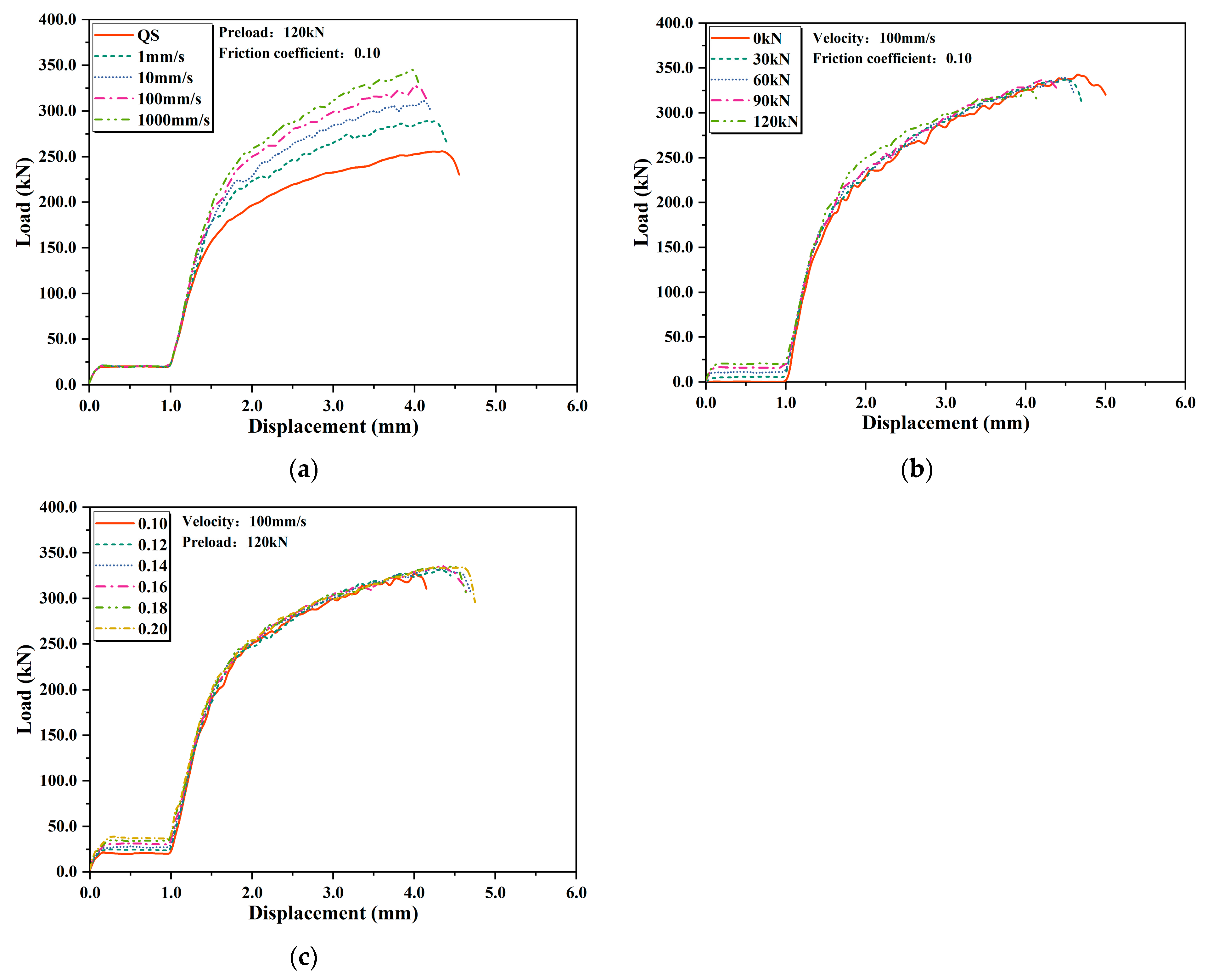
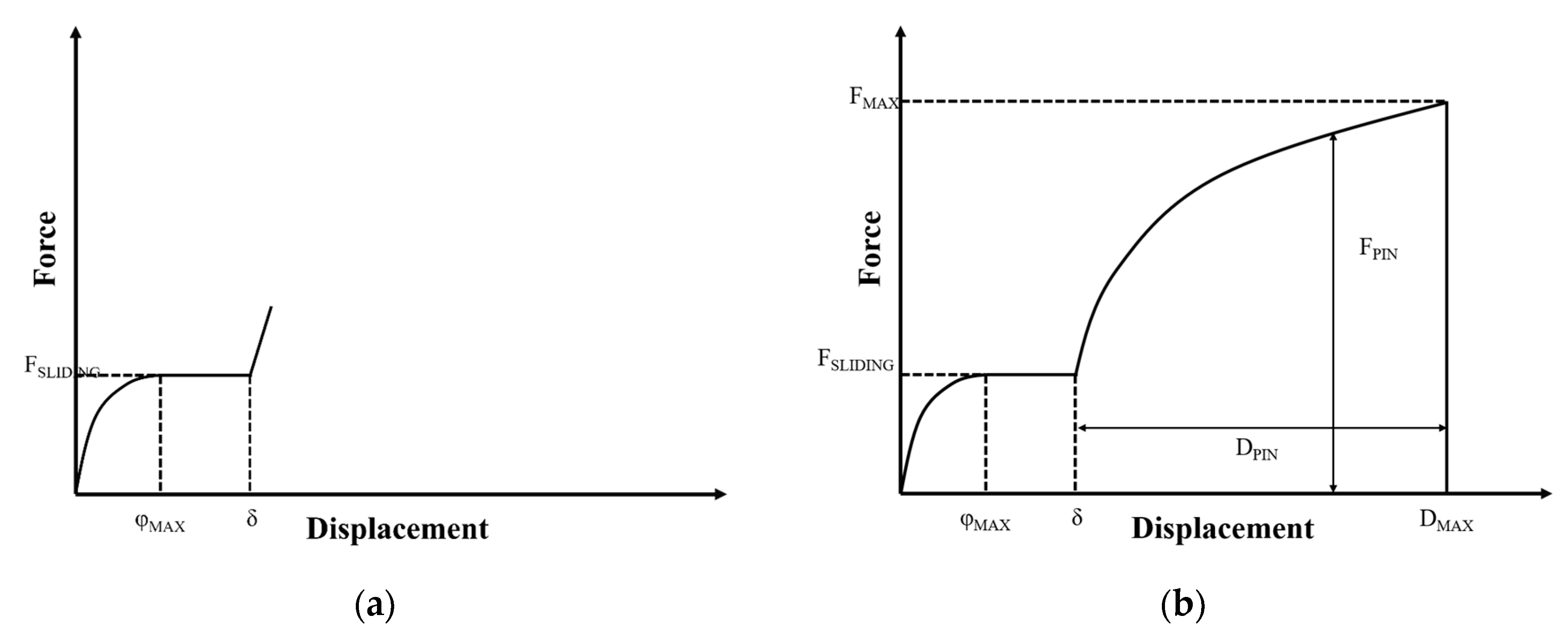

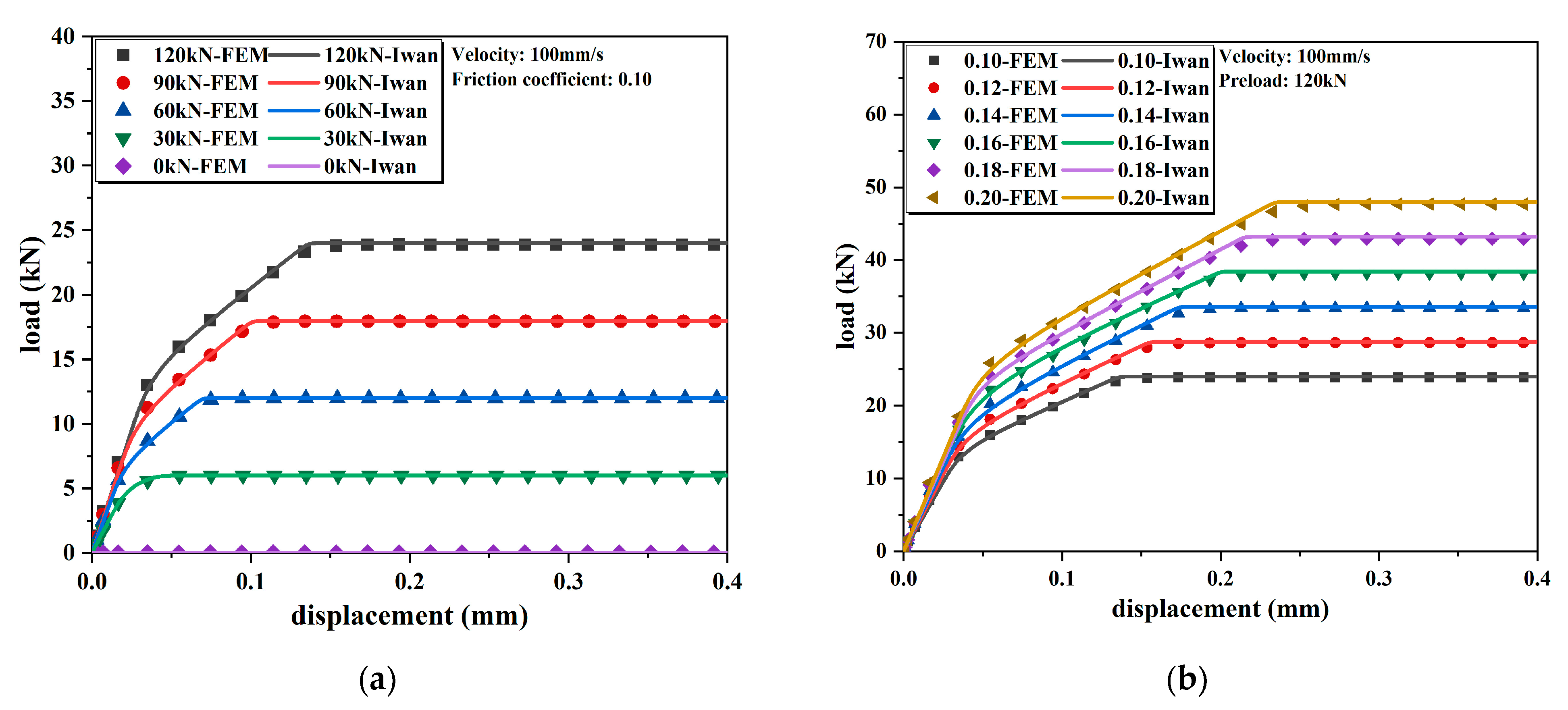

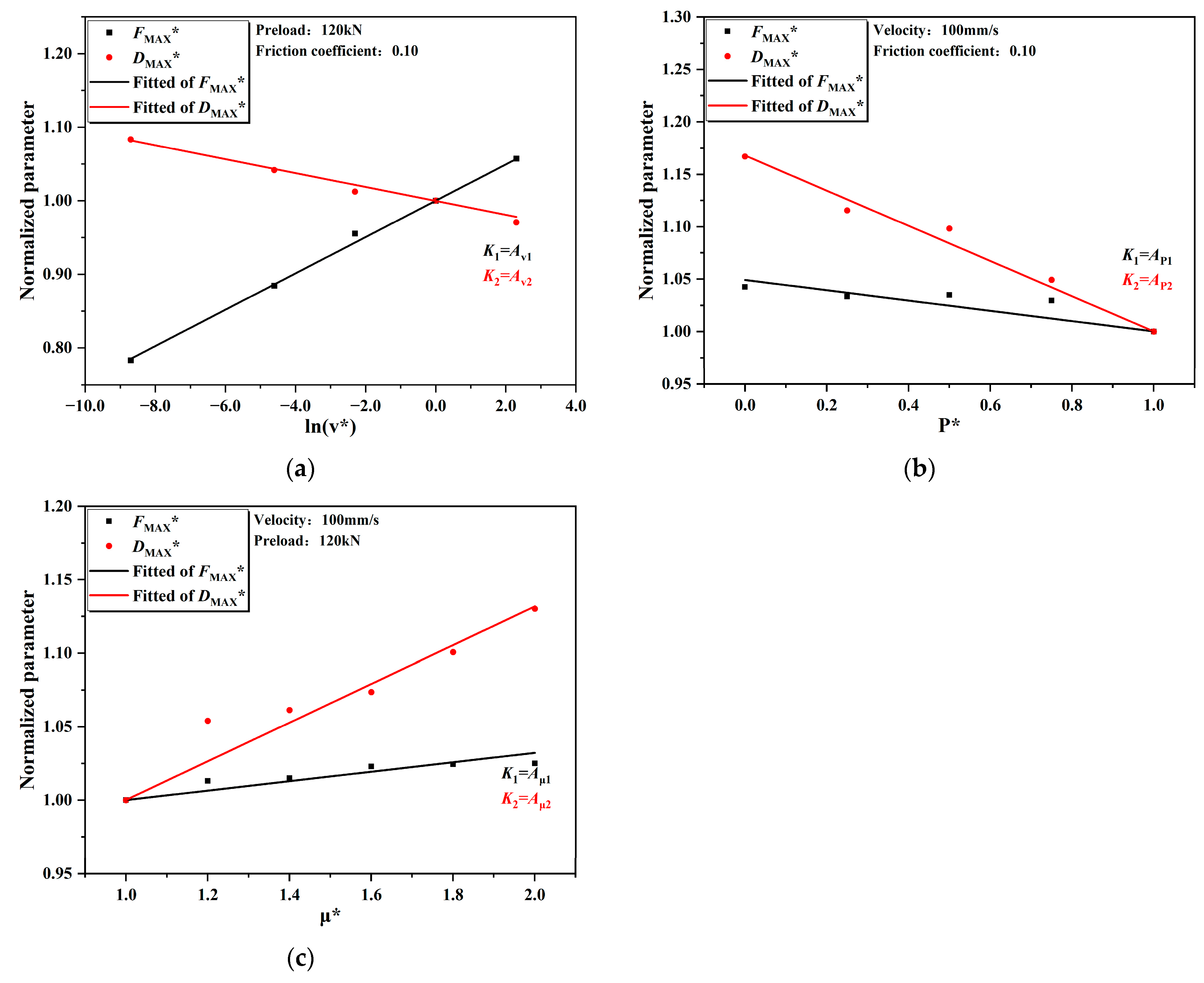
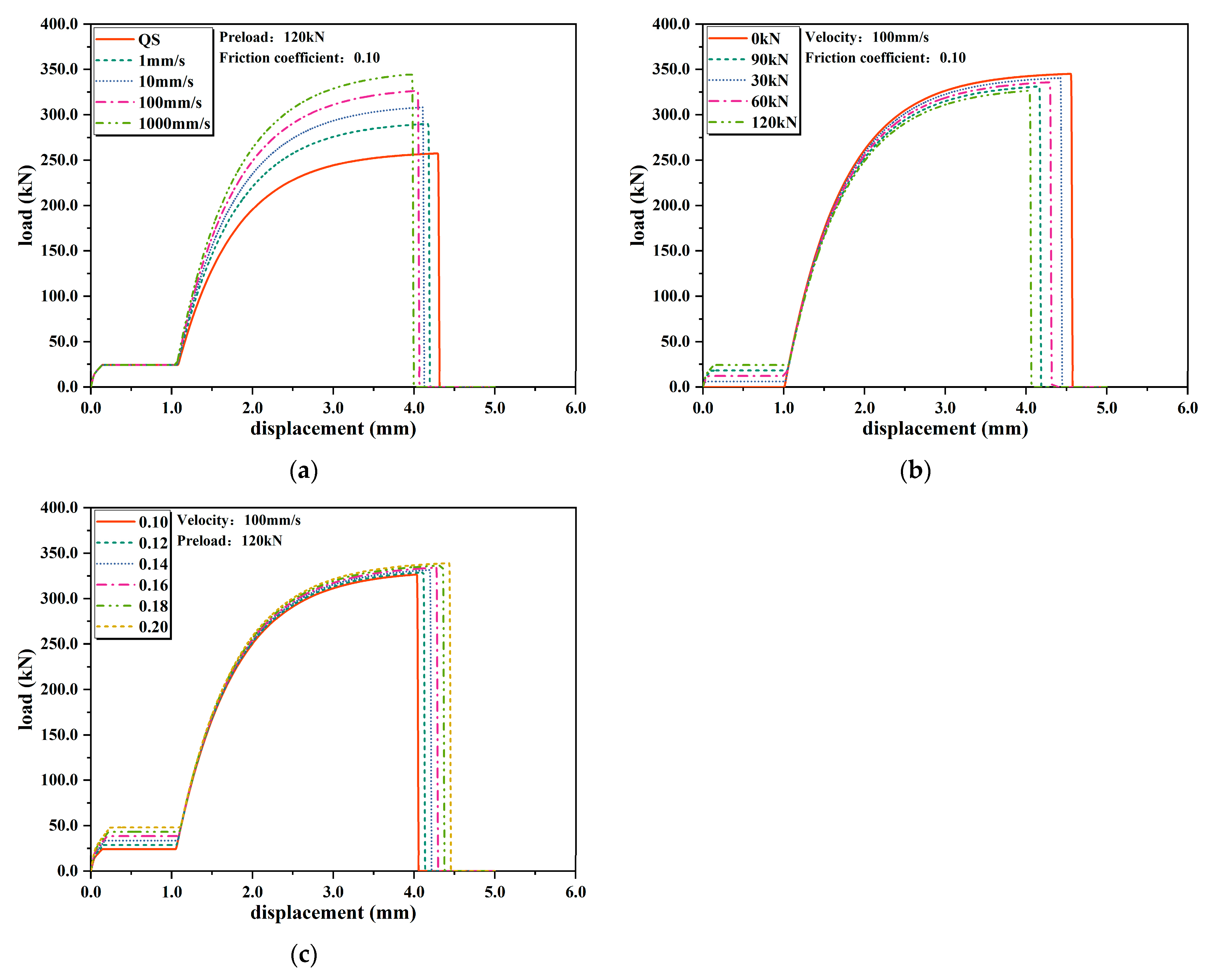
| Component | Material | E (GPa) | ν | Ρ (kg/m3) | A (MPa) |
|---|---|---|---|---|---|
| Plates | Q355B steel | 206 | 0.28 | 7850 | 339.45 |
| Bolt and Nut | 45 steel | 206 | 0.28 | 7850 | 714 |
| B (MPa) | C | n | m | Tm (°C) | Tr (°C) |
| 620 | 0.045 | 0.412 | 0.66 | 1800 | 293 |
| 563 | 0.037 | 0.52 | 0.7 | 1808 | 293 |
| (s−1) | D1 | D2 | D3 | D4 | D5 |
| 1.33 × 10−3 | 0.81 | 6.05 | −7.09 | −0.003 | 2.0 |
| 8.33 × 10−4 | 0.10 | 0.76 | 1.57 | 0.005 | −0.84 |
| Velocity (mm/s) | Preload (kN) | Friction Coefficient | Critical Load (kN) | ||
|---|---|---|---|---|---|
| Simulation | EC-3 | Error (%) | |||
| QS | 120 | 0.10 | 256.4 | 255.6 | −0.31 |
| 1 | 120 | 0.10 | 289.6 | 255.6 | −11.74 |
| 10 | 120 | 0.10 | 312.8 | 255.6 | −18.29 |
| 100 | 120 | 0.10 | 327.4 | 255.6 | −21.93 |
| 1000 | 120 | 0.10 | 346.2 | 255.6 | −26.17 |
| 100 | 90 | 0.10 | 337.1 | 255.6 | −24.18 |
| 100 | 60 | 0.10 | 338.8 | 255.6 | −24.56 |
| 100 | 30 | 0.10 | 338.3 | 255.6 | −24.45 |
| 100 | 0 | 0.10 | 341.3 | 255.6 | −25.11 |
| 100 | 120 | 0.12 | 331.7 | 255.6 | −22.94 |
| 100 | 120 | 0.14 | 332.3 | 255.6 | −23.08 |
| 100 | 120 | 0.16 | 334.9 | 255.6 | −23.68 |
| 100 | 120 | 0.18 | 335.4 | 255.6 | −23.79 |
| 100 | 120 | 0.20 | 335.6 | 255.6 | −23.84 |
| Velocity (mm/s) | Preload (kN) | Friction Coefficient | Critical Load (kN) | ||
|---|---|---|---|---|---|
| Simulation | DICF Model | Error (%) | |||
| QS | 120 | 0.10 | 256.4 | 257.5 | 0.43 |
| 1 | 120 | 0.10 | 289.6 | 290.1 | 0.17 |
| 10 | 120 | 0.10 | 312.8 | 308.4 | −1.41 |
| 100 | 120 | 0.10 | 327.4 | 326.6 | −0.24 |
| 1000 | 120 | 0.10 | 346.2 | 344.7 | −0.43 |
| 100 | 90 | 0.10 | 337.1 | 331.3 | −1.72 |
| 100 | 60 | 0.10 | 338.8 | 336.0 | −0.83 |
| 100 | 30 | 0.10 | 338.3 | 340.5 | 0.65 |
| 100 | 0 | 0.10 | 341.3 | 345.0 | 1.08 |
| 100 | 120 | 0.12 | 331.7 | 329.2 | −0.75 |
| 100 | 120 | 0.14 | 332.3 | 331.7 | −0.18 |
| 100 | 120 | 0.16 | 334.9 | 334.2 | −0.21 |
| 100 | 120 | 0.18 | 335.4 | 336.7 | 0.38 |
| 100 | 120 | 0.20 | 335.6 | 339.1 | 1.04 |
Disclaimer/Publisher’s Note: The statements, opinions and data contained in all publications are solely those of the individual author(s) and contributor(s) and not of MDPI and/or the editor(s). MDPI and/or the editor(s) disclaim responsibility for any injury to people or property resulting from any ideas, methods, instructions or products referred to in the content. |
© 2024 by the authors. Licensee MDPI, Basel, Switzerland. This article is an open access article distributed under the terms and conditions of the Creative Commons Attribution (CC BY) license (https://creativecommons.org/licenses/by/4.0/).
Share and Cite
Chen, H.; Hao, Z.; Kuang, J.; Li, J. A Dynamic Iwan Model to Describe the Impact Failure of Bolted Joints. Buildings 2024, 14, 2572. https://doi.org/10.3390/buildings14082572
Chen H, Hao Z, Kuang J, Li J. A Dynamic Iwan Model to Describe the Impact Failure of Bolted Joints. Buildings. 2024; 14(8):2572. https://doi.org/10.3390/buildings14082572
Chicago/Turabian StyleChen, Hao, Zhiming Hao, Jinxin Kuang, and Jicheng Li. 2024. "A Dynamic Iwan Model to Describe the Impact Failure of Bolted Joints" Buildings 14, no. 8: 2572. https://doi.org/10.3390/buildings14082572






